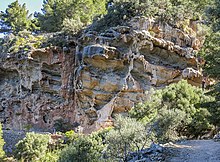


Karst (/kɑːrst/) is a topography formed from the dissolution of soluble carbonate rocks such as limestone and dolomite. It is characterized by features like poljes above and drainage systems with sinkholes and caves underground.[1][2] There is some evidence that karst may occur in more weathering-resistant rocks such as quartzite given the right conditions.[3]
Subterranean drainage may limit surface water, with few to no rivers or lakes. In regions where the dissolved bedrock is covered (perhaps by debris) or confined by one or more superimposed non-soluble rock strata, distinctive karst features may occur only at subsurface levels and can be totally missing above ground.[4]
The study of paleokarst (buried karst in the stratigraphic column) is important in petroleum geology because as much as 50% of the world's hydrocarbon reserves are hosted in carbonate rock, and much of this is found in porous karst systems.[5]
- ^ "What is Karst?" (PDF). Environmental Science Institute. The University of Texas at Austin. 16 May 2006. Retrieved 25 December 2020.
- ^ Jackson, Julia A., ed. (1997). "Karst". Glossary of geology (Fourth ed.). Alexandria, Virginia: American Geological Institute. ISBN 0922152349.
- ^ Doerr, S. H. (18 March 1999). "Karst-like landforms and hydrology in quartzites of the Venezuelan Guyana shield: Pseudokarst or "real" karst?". Zeitschrift für Geomorphologie. 43 (1): 1–17. Bibcode:1999ZGm....43....1D. doi:10.1127/zfg/43/1999/1.
- ^ Billi, Andrea; De Filippis, Luigi; Poncia, Pier Paolo; et al. (February 2016). "Hidden sinkholes and karst cavities in the travertine plateau of a highly-populated geothermal seismic territory (Tivoli, central Italy)". Geomorphology. 255: 63–80. Bibcode:2016Geomo.255...63B. doi:10.1016/j.geomorph.2015.12.011.
- ^ Cite error: The named reference
Derek2007was invoked but never defined (see the help page).